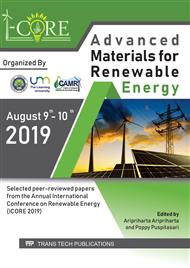[1]
R.K. Sharma, Use of HDPE implants in facial skeletal augmentation: Should we rush for it?, Indian J Plast Surg. 43(2010) 40–41.
DOI: 10.1055/s-0039-1699401
Google Scholar
[2]
N.J. Mokal, M.F Desai, Calvarial reconstruction using high-density porous polyethylene cranial hemispheres, Indian J Plast Surg. 44 (2011) 422-431.
DOI: 10.4103/0970-0358.90812
Google Scholar
[3]
D. Banoriya, R. Purohit, R.K. Dwivedi, Advanced Application of Polymer based Biomaterials, Materials Today: Proceedings. 4(2017), Part A, 3534-3541.
DOI: 10.1016/j.matpr.2017.02.244
Google Scholar
[4]
I. Fernandez-Bueno, S.D Lauro, I. Alvarez, J.C. Lopez, M.T. Garcia-Gutierrez, I. Fernandez, E. Larra, J.C. Pastor, Safety and biocompatibility of a new high-density polyethylene-based spherical integrated porous orbital implant: an experimental study in rabbits, Journal of Ophthalmology, 2015(2015) Article ID 904096.
DOI: 10.1155/2015/904096
Google Scholar
[5]
S. Xu, A. Akchurin, T. Liu, W. Wood, X.W. Tangpong, I.S Akhatov, W.-H. Zhong, Mechanical properties, tribological behavior, and biocompatibility of high-density polyethylene/carbon nanofibers nanocomposites, Journal of Composite Materials, 49(2015) 1503-1512.
DOI: 10.1177/0021998314535959
Google Scholar
[6]
V.C. McLain, Final report on the safety assessment of polyethylene, Int J Toxicol. 26 (2007) 115-127.
Google Scholar
[7]
A. Martínez-Romo, R. González-Mota, J.J. Soto-Bernal, I. Rosales-Candelas, Investigating the degradability of HDPE, LDPE, PE-BIO, and PE-OXO films under UV-B radiation, J Spectrosc. 2015 (2015) Article ID 586514.
DOI: 10.1155/2015/586514
Google Scholar
[8]
K.A. Jassim, W.H. Jassim, S.H. Mahdi, The effect of sunlight on medium density polyethylene water pipes, Energy Procedia. 119 (2017) 650-655.
DOI: 10.1016/j.egypro.2017.07.091
Google Scholar
[9]
E. Erawati, Hamid, A.A. Ilma, Pyrolysis Process of Mixed Polypropylene (PP) and High-Density Polyethylene (HDPE) Waste with Natural Zeolite as Catalyst, Molekul 13 (2018) 106-113.
DOI: 10.20884/1.jm.2018.13.2.400
Google Scholar
[10]
Purnomo, P.H. Setyarini, Atmospheric-pressure annealing effect on the impact fracture toughness of injection-molded zeolite-HDPE composite, International Review of Mechanical Engineering 12 (2018) 556-562.
DOI: 10.15866/ireme.v12i6.15034
Google Scholar
[11]
Purnomo, P.H. Setyarini, D. Sulistyaningsih, Zeolite-based biomaterials for biomedical application: A review, AIP Conference Proceedings 1977 (2018) 030013.
DOI: 10.1063/1.5042933
Google Scholar
[12]
Purnomo, M. Subri, P.H. Setyarini, Fracture development and deformation behavior of zeolite-filled high density polyethylene annealed composites in the plane stress fracture, FME Transactions 46 (2018) 165-170.
DOI: 10.5937/fmet1802157z
Google Scholar
[13]
Purnomo, M. Subri, Post-yield fracture behavior of zeolite-reinforced high density polyethylene annealed composite, International Review of Mechanical Engineering 11 (2017) 87-93.
DOI: 10.15866/ireme.v11i1.10542
Google Scholar
[14]
A. Zotti, S. Zuppolini, A. Borriello, M. Zarrelli, Thermal properties and fracture toughness of epoxy nanocomposites loaded with hyperbranched-polymers-based core/shell nanoparticles, Nanomaterials (Basel) 9 (2019) 418.
DOI: 10.3390/nano9030418
Google Scholar
[15]
L. Qian, T. Kobayashi, H. Toda, T. Goda, Z.-g. Wang, Fracture toughness of a 6061Al matrix composite reinforced with fine SiC particles, Mater Trans. 43 (2002) 2838 – 2842.
DOI: 10.2320/matertrans.43.2838
Google Scholar
[16]
T. Nazir, A. Afzala, H.M. Siddiqi, Z. Ahmad, M. Dumon, Thermally and mechanically superior hybrid epoxy–silica polymer films via sol–gel method. Prog. Org. Coat. 69 (2010) 100–106.
DOI: 10.1016/j.porgcoat.2010.05.012
Google Scholar
[17]
D. Quan, A. Ivankovic, Effect of coreeshell rubber (CSR) nano-particles on mechanical properties and fracture toughness of an epoxy polymer. Polymer 66 (2015) 16–28.
DOI: 10.1016/j.polymer.2015.04.002
Google Scholar
[18]
A.Y. Al-Maharma, P. Sendur, N. Al-Huniti, Critical review of the factors dominating the fracture toughness of CNT reinforced polymer composites, Mater Res Express. 6 (2018) 012003.
DOI: 10.1088/2053-1591/aae867
Google Scholar
[19]
D. Liu, B. Šavija, G.E. Smith, P.E.J. Flewitt, T. Lowe, E. Schlangen, Towards understanding the influence of porosity on mechanical and fracture behaviour of quasi-brittle materials: experiments and modelling, Int J Fract. 205 (2017) 57–72.
DOI: 10.1007/s10704-017-0181-7
Google Scholar
[20]
J. Hohe, S. Luckow, V. Hardenacke, Y. Sguaizer, D. Siegele, Enhanced fracture assessment under biaxial external loads using small scale cruciform bending specimens, Eng. Fract. Mech. 78 (2011) 1876-1894.
DOI: 10.1016/j.engfracmech.2011.03.013
Google Scholar
[21]
G.A. Pantazopoulos, A short review on fracture mechanisms of mechanical components operated under industrial process conditions: fractographic analysis and selected prevention strategies, Metals 9 (2019) 148.
DOI: 10.3390/met9020148
Google Scholar
[22]
D. Abdelkader, B. Mostefa, A. Aid, A. Talha, N. Benseddiq, B. Mohamed, Experimental analysis and damage modeling of high-density polyethylene under fatigue loading, Acta Mech Solida Sin. 29 (2016) 133-144.
DOI: 10.1016/s0894-9166(16)30102-1
Google Scholar
[23]
E.Q. Clutton, ESIS TC4 experience with the essential work of fracture method, European Structural Integrity Society 27 (2000) 187-199.
DOI: 10.1016/s1566-1369(00)80018-7
Google Scholar
[24]
F. Awaja, S. Zhang, M. Tripathi, A. Nikiforov, N. Pugno. Cracks, microcracks and fracture in polymer structures: Formation, detection, autonomic repair, Progress in Materials Science 83 (2016) 536–573.
DOI: 10.1016/j.pmatsci.2016.07.007
Google Scholar
[25]
B.R.K. Chunchu, J. Putta, Rheological and strengt behavior of binary blended SCC replacing partial fine aggregate with plastic e-waste as high impact polystyrene, Buildings 9 (2019) 50.
DOI: 10.3390/buildings9020050
Google Scholar
[26]
K. Fujimoto, Z. Tang, W. Shinoda, S. Okazaki, All-atom molecular dynamics study of impact fracture of glassy polymers. I: Molecular mechanism of brittleness of PMMA and ductility of PC, Polymer, Volume 178 (2019), 121570.
DOI: 10.1016/j.polymer.2019.121570
Google Scholar


